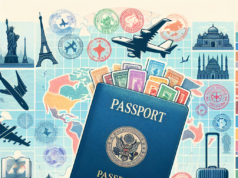
Identification Cards: The Key to Security and Efficiency
Introduction
With the ever-growing population and increasing number of transactions in our daily lives, it has become necessary for governments to implement a system that ensures the identification of individuals. Identification cards have become a common solution adopted by several countries worldwide to improve their security and facilitate day-to-day transactions. The card serves as a personal identity document that contains essential information about the individual, including their name, photo, and address.
This article explores the advantages and challenges of implementing identification cards, its effectiveness in improving security and efficiency, and the potential risks associated with its use. It also includes an update on the latest government resources on the topic.
Advantages of Identification Cards
Identification cards offer several advantages to individuals and the government. Some of the benefits include:
1. Personal Identification
Identification cards are a reliable way of identifying individuals and verifying their identity. In situations where a person needs to provide their identity, such as at work, voting, airports, and hospitals, the card serves as evidence of who they are. This significantly reduces the risk of impersonation and fraud.
2. Improved Security
Identification cards are a crucial element in improving security. They act as a mechanism of control at sensitive locations such as airports, government buildings, and military installations. With proper identification cards, the authorities can easily identify and track people who have authorized access to such locations. Additionally, identification cards can be used to prevent criminal activities, including identity theft and financial fraud.
3. Efficiency
Identification cards are a valuable asset in improving day-to-day transactions, including financial interactions, voting, and transportation. By using identification cards, individuals can easily and quickly access various services and facilities. For instance, identification cards are a key requirement in opening bank accounts, applying for a loan, or obtaining permits.
4. National Integration
Identification cards enhance national integration by promoting the unity of all citizens. Through identification, people feel a sense of belonging and ownership in their country. Additionally, identification cards serve as an essential element in combating illegal immigration by verifying the legal status of individuals.
5. Medical Records
Some identification cards include a person’s medical history, which could be beneficial in ensuring that patients receive adequate medical attention quickly. This information is crucial in emergency situations, where access to medical history could save lives.
Challenges of Identification Cards
Despite the numerous benefits of identification cards, there are several challenges that could affect their effectiveness. Some of these challenges include:
1. Cost of Implementation
The cost of implementing a comprehensive identification card system could be an obstacle to adoption. The implementation of such a system requires significant investment in infrastructure, technological tools, and personnel. Additionally, the establishment of the necessary legal framework and administrative mechanisms could be an extensive and lengthy process.
2. Privacy Concerns
The collection and storage of personal data on the identification card raise privacy concerns. The potential misuse of personal data by the authorities could result in a breach of personal privacy, which could significantly harm individuals.
3. Security Risks
Identification cards are not foolproof and could be vulnerable to hacking, forgery, and duplication. In cases of theft or loss, the identification card could be used to impersonate the owner, resulting in identity theft or financial fraud.
4. Discrimination
Identification cards could be used to discriminate against certain groups of individuals, including immigrants, refugees, or minorities. Such a system could lead to the marginalization and stigmatization of such groups.
5. Technological Limitations
Identification cards rely on technology, which could be subject to failure. Technical glitches could impact a person’s ability to access essential services or result in incorrect information about them.
Effectiveness of Identification Card Systems
Numerous countries worldwide have implemented identification card systems, and the results have been mixed. Some countries have achieved significant success in improving security, efficiency, and personal identification. For example, Singapore, which introduced the National Registration Identity Card (NRIC) system has achieved high levels of security, with exceptionally low fraud rates.
Additionally, the United Arab Emirates, which implemented the Emirates ID, has significantly reduced the cost and time involved in transactions such as opening bank accounts, registration at hospitals, and voting.
In contrast, some countries have encountered challenges in implementing identification card systems. For example, Mexico’s national identification card system faced significant challenges due to the high cost of implementation and concerns over privacy and corruption. Therefore, it is essential to plan and execute effectively while considering the unique challenges of the country when introducing an identification card system.
Government Resources on Identification Cards
Governments worldwide have developed comprehensive resources to guide policymakers on the implementation of identification card systems. These resources include:
1. United States
The REAL ID Act 2005 established the identification card system in the United States. The act sought to improve the security of driver licenses and state identification cards. The Department of Homeland Security (DHS) oversees the implementation of the REAL identification card system and has a comprehensive website that provides information on the requirements and implementation status.
2. Singapore
Singapore’s government has a National Registration Identity Card (NRIC) system used to identify and verify individuals. The country’s Immigration and Checkpoints Authority (ICA) oversees the implementation of the system and has established comprehensive guidelines on the use of NRICs.
3. United Arab Emirates
The United Arab Emirates implemented an Emirates ID system. The Federal Authority for Identity and Citizenship (ICA) oversees the implementation of the identification card system and has established a comprehensive website that provides information on the requirements and implementation status.
4. Mexico
Mexico’s government established the National Identification System (SNI) as part of its efforts to combat crime and improve security. The Federal Ministry of the Interior is responsible for the implementation of the system. The ministry has published guidelines on the use and management of the national identification card.
Conclusion
Identification cards are a valuable tool in improving efficiency, security and personal identification in both public and private sectors. However, implementation requires careful planning, commitment, and significant investment. It is crucial to acknowledge and address potential challenges such as privacy concerns and technological limitations while developing and implementing an identification card system.
The effectiveness of identification card systems varies depending on the socio-economic and political context of the country. Governments worldwide have developed a range of resources to guide policymakers on the implementation of identification cards, which consider both the benefits and challenges associated with such a system.
The Facts about Identification Cards
Identification cards are used for individuals who either do not or cannot drive, and therefore do not hold a driver’s license. The purpose of the identification card is to provide a form of identification that can be used to verify an individual’s age, although it can go further by verifying a signature or state residency.
It is very useful for an individual without a license to have an identification card. Having one can allow the individual to view R-rated movies, purchase alcohol and tobacco, board a plane, cash a check, enter bars and night clubs, registering to vote, becoming an organ donor, or check into a hotel without needing a license.
The individuals who usually obtain an identification card include:
Individuals who do not have a driver’s license due to personal preference
Individuals who do not have a driver’s license because of age restrictions
Individuals who have had their driver’s licenses suspended
A State identification card is usually almost nearly identical to a driver’s license, although somewhere on the card it will state that the card is just for identification purposes only. This can also apply to age-dependent licenses, where a 21 and over ID may have a certain orientation or color that corresponds to that of a driver’s license for an individual who is over 21.
A state may also provide different types of identification cards. For example, Illinois allows the issuing of three different identification cards. They are for individuals over 65 (a Senior Card), an individual under 65, and an individual who is disabled.
How to Obtain an Identification Card
For all states, identification cards can be obtained through the local Department of Motor Vehicles or equivalent driver agency. All states require certain pieces of information and documents in order to issue an identification card to an individual. In order to receive an identification card, an individual may have to show:
Proof of identity
Proof of age
Proof of residence (particularly residence in that state)
Signature
Valid social security number or social security ineligibility
Lawful Status
What Else to Know About Identification Cards
Depending on the state, there are different procedures involving identification cards. Typically, states charge between $10-20 for an identification card, but the prices can heavily vary. For example, an identification card costs only $8 in Montana, but costs $44.50 in Oregon.
If an identification card is lost or stolen or has expired, each Department of Motor Vehicles or equivalent agencies has certain procedures set in order to replace the identification card. Depending on the situation and state, there can be a replacement or renewal fee that is similar to the cost of initially getting the card. It is usually necessary to bring the forms of identification and proof of information during these circumstances.



























